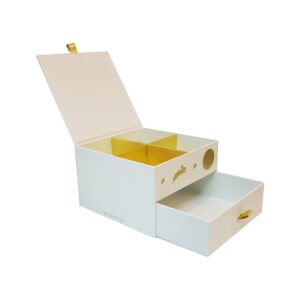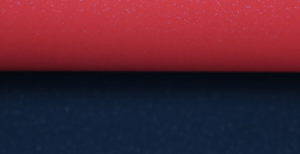White chipboard, also known as white-lined chipboard (WLC), is a type of paperboard that consists of multiple layers. The outer layers are typically made of bleached white paper, while the inner layer or core is made of recycled paper fibers. This construction gives white chipboard its characteristic appearance and properties. Here are some key features and uses of white chipboard:
- Color and Appearance: As the name suggests, white chipboard has a bright white or off-white color on its outer surfaces. This makes it aesthetically pleasing and suitable for applications where a clean and professional appearance is desired.
- Thickness and Density: White chipboard comes in various thicknesses, ranging from lightweight options to thicker boards that offer more rigidity and durability. The density of the board can also vary, with denser boards providing better strength and stiffness.
- Surface Finish: The surface of the white chipboard can be smooth or slightly textured, depending on the manufacturing process and intended use. It can be left untreated for a natural look or coated with materials like clay or other additives to enhance its properties.
- Printability: White chipboard is highly printable, making it suitable for packaging and promotional materials that require vibrant graphics, text, or branding. It accepts printing techniques such as offset printing, digital printing, and screen printing effectively.
- Applications: White chipboard has a wide range of applications across industries, including but not limited to:
- Packaging material for boxes, cartons, displays, and inserts.
- They are backing for notepads, notebooks, calendars, and other stationery items.
- Graphic arts and printing applications, including posters, folders, and signage.
- Educational materials, game boards, puzzles, and craft projects.
- Environmental Considerations: While white chipboard may contain recycled content in its core, the bleached white paper used for its outer layers may involve chemical processes. However, some manufacturers offer eco-friendly options with sustainable sourcing practices and reduced environmental impact.
- Cost-Effectiveness: White chipboard is generally more affordable than some other packaging materials, making it a cost-effective choice for various applications. It provides a good balance of quality, functionality, and affordability.
What is the difference between white chipboard and grey chipboard?
Grey chipboard and white chipboard are two types of paperboard materials that are commonly used for various applications. Here are the key differences between them:
- Color:
- Grey chipboard, as the name suggests, has a grey or grayish color. It is typically made from recycled paper products and may have visible flecks or specks due to its recycled content.
- White chipboard, on the other hand, is usually bleached to achieve a white or off-white color. It may also be made from recycled materials but undergoes a bleaching process to give it a cleaner appearance.
- Appearance:
- Grey chipboard has a more rustic or industrial look due to its natural grey color and visible recycled fibers.
- White chipboard has a cleaner and more uniform appearance due to its bleaching process, making it suitable for applications where a pristine appearance is desired.
- Strength and Thickness:
- Both grey and white chipboard come in various thicknesses and strengths. However, the strength and thickness can vary depending on the specific manufacturer and intended use.
- Generally, chipboard is known for its sturdiness and ability to provide a rigid backing for products like notepads, notebooks, packaging inserts, and backing boards for artwork or documents.
- Applications:
- Grey chipboard is often used for applications where the appearance is less critical, such as backing boards for notepads, sketchbooks, or as a protective layer in packaging.
- White chipboard is preferred for applications where a cleaner and more professional appearance is required, such as high-end packaging, presentation folders, or premium product backing.
- Printing and Customization:
- Both types of chipboard can be printed on, but the printing results may vary slightly due to the base color. White chipboard provides a more accurate color representation when printing compared to grey chipboard, which may affect the final appearance of printed designs.
In summary, the main differences between grey chipboard and white chipboard lie in their color, appearance, and suitability for different applications. Grey chipboard is more commonly used in industrial or less visually critical applications, while white chipboard is favored for its clean appearance and suitability for higher-end products.
Overall, white chipboard is valued for its versatility, printability, and clean appearance, making it a popular choice for packaging, printing, and graphic arts applications where a white or bright background is desired.



